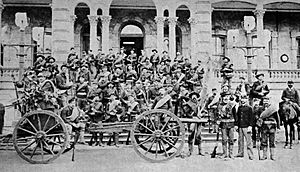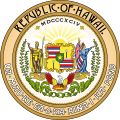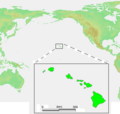Republic of Hawaii facts for kids
Quick facts for kids
Republic of Hawaii
Lepupalika o Hawaiʻi
|
|||||||||
|---|---|---|---|---|---|---|---|---|---|
| 1894–1898 | |||||||||
|
Motto: Ua Mau ke Ea o ka ʻĀina i ka Pono
|
|||||||||
|
Anthem: "Hawaiʻi Ponoʻī"
|
|||||||||
 |
|||||||||
| Capital | Honolulu | ||||||||
| Common languages | English, Hawaiian | ||||||||
| Government | One-party republic | ||||||||
|
• President
|
Sanford B. Dole | ||||||||
| History | |||||||||
|
• Established
|
4 July 1894 | ||||||||
| 6 January 1895 | |||||||||
|
• Restoration attempt ends
|
9 January 1895 | ||||||||
| 12 August 1898 | |||||||||
| Currency | Hawaiian dollar | ||||||||
|
|||||||||
| Today part of | United States | ||||||||
The Republic of Hawaii (Hawaiian: Lepupalika o Hawaiʻi) was a country in Hawaii that lasted only a short time. It existed from July 4, 1894, to August 12, 1898. Before this, Hawaii was ruled by a temporary government. After 1898, Hawaii became a part of the United States.
The Republic was formed after the Hawaiian Kingdom was overthrown in 1893. This happened when Queen Liliʻuokalani was removed from power. She had disagreed with an earlier constitution that limited the king's power. The people who took over wanted Hawaii to join the United States. However, the U.S. President at the time, Grover Cleveland, did not agree with this plan.
Leaders of the Republic, like Sanford B. Dole, were Hawaiians whose families came from America. They spoke the Hawaiian language and had strong ties to the United States. They hoped Hawaii would become a U.S. territory. Hawaii finally joined the U.S. under President William McKinley in 1898. This happened during the Spanish–American War.
A report called the Blount Report later showed that the United States had helped in the overthrow of the Hawaiian government. U.S. Marines were sent to Hawaii by an American official. This report said that these actions helped the revolution succeed. It also said that most Hawaiian people did not want the revolution.
Contents
How the Republic of Hawaii Started
In 1887, a group called the Reform Party made the Hawaiian King accept a new constitution. This new rule, known as the Bayonet Constitution, greatly limited the King's power. It was called "Bayonet" because threats were used to make the King agree. This made the King a figurehead, meaning he had little real power.
In 1893, a group of wealthy sugar planters and businessmen took over the government. More than 1,000 armed local men were involved. There was no fighting, as the royal army did not resist. A temporary government, called the Provisional Government of Hawaii, was then set up. The leaders of this takeover had strong business ties to the United States. They wanted Hawaii to join the U.S., partly because they worried Japan might try to take control.
However, joining the U.S. was delayed. Many Native Hawaiians signed petitions against it. Also, U.S. President Cleveland did not support the idea. Queen Liliʻuokalani even went to Washington D.C. to try and get her power back.
President Cleveland sent an investigator, who wrote the Blount Report. This report said that a U.S. official had helped plan the overthrow. Cleveland wanted to bring the Queen back to power. He asked the new Hawaiian leader, Sanford B. Dole, to step down. But Dole refused. The U.S. Senate then looked at another report, the Morgan Report, which disagreed with the Blount Report. Many people in the U.S. wanted Hawaii to be annexed. In the end, President Cleveland dropped the issue. This left the Republic of Hawaii to manage on its own.
The temporary government then held a meeting to write a new constitution. Only Hawaiians and taxpayers of American or European background could take part. People of Asian descent were not included.
Government of the Republic
The President of Hawaii was both the head of state and the head of government. The constitution said a president would serve for six years. A president could not be elected for two terms in a row. The President could stop new laws, but the Legislature could overrule this. The President was also the leader of the military.
The President chose people for his Cabinet, but the Senate had to approve them. Cabinet members could speak in the Legislature but could not vote. If the President's job became empty, the Minister of Foreign Affairs could act as President. This would last until the Legislature chose a new one.
The 1894 constitution named Sanford B. Dole as the first President. He was also the only President of the Republic. When Hawaii joined the U.S. in 1898, Dole became its first Governor.
The Republic's Legislature had two parts: a Senate and a House of Representatives. Each had fifteen members. Senators served for six years, and representatives for two years. The first group of representatives served for three years. Bills about money started with the Minister of Finance and went to the Senate. The Senate also approved the President's choices and treaties. This made the Senate more powerful than the House. It was possible for lawmakers to also be President, a Cabinet minister, or a Supreme Court judge.
Royalists, who supported the Queen, did not take part in the Republic's elections. They refused to promise loyalty to the new government. Because of this, the American Union Party won every seat in the 1894 and 1897 elections. To vote for Senators, a person had to own property worth at least $1500. This rule came from the 1887 constitution. The 1897 election had very few voters. Less than one percent of the population voted.
The new Republic Constitution allowed only men who were born in the Hawaiian Kingdom or had become citizens to vote. This meant most Japanese, Chinese, Portuguese, and European immigrants could not vote. As a result, Native Hawaiians made up most of the voters. They were the largest group in the Republic Legislature. The Speaker of the House was also a Hawaiian, John Lot Kaulukoʻu.
Wilcox Rebellion of 1895
Robert William Wilcox was a Hawaiian who led revolts. In 1889, he led a group against the Hawaiian Kingdom. He was put on trial but found not guilty. In 1895, Wilcox tried again. This time, he wanted to overthrow the Republic of Hawaii. His goal was to bring Queen Liliuokalani back to power.
Supporters of the Queen secretly brought weapons and ammunition from San Francisco. They hid them in Honolulu. On January 6, 1895, a group of royalists met to plan taking over government buildings. But they were discovered early by police. This alerted Honolulu, and their plans failed. The royalists were quickly defeated. Wilcox hid in the mountains for several days before being caught.
During the next week, there were more small fights. The main plotters and their followers were captured. The government found weapons and documents at Queen Liliuokalani's home. These papers, written by her, showed who she would choose for her government if the revolt succeeded. This linked her to the plot.
Trial of Queen Liliuokalani
The Republic of Hawaii put the former Queen on trial. The government said that Liliuokalani knew about the weapons. They claimed guns and bombs for the revolt were hidden in her garden. Liliuokalani said these claims were not true.
She was sentenced to five years in prison and a fine of $10,000. However, her "imprisonment" was in a large bedroom at Iolani Palace. She had a piano, a bathroom with hot and cold water, and two maids. Guards watched her at all times. After eight months, she was allowed to go to her home, Washington Place. She stayed there under house arrest, watched by President Sanford B. Dole.
A year later, she received a full pardon. She was even given a passport to travel. President Dole allowed her to visit friends in Washington D.C. But she used this chance to speak against Hawaii joining the U.S. in 1897.
End of the Republic and Annexation
When William McKinley became the U.S. President in March 1897, talks about Hawaii joining the U.S. started again. These talks continued into the summer of 1898. In April 1898, the United States began a war with Spain. The Republic of Hawaii said it would stay neutral, meaning it would not pick a side.
But in reality, Hawaii gave a lot of help to the United States. It showed how useful it could be as a naval base during wartime. This made many Americans approve of Hawaii's actions.
With less opposition, Hawaii was annexed by the Newlands Resolution. This law only needed a majority vote in both houses of the U.S. Congress. Most of the support came from Republicans. The House of Representatives voted 209 to 91 in favor. It was approved on July 4, 1898, and signed by President McKinley on July 7.
Hawaii officially became part of the U.S. on August 12, 1898. On that day, the Hawaiian flag was lowered. The U.S. flag was raised over the former royal ʻIolani Palace. The Republic of Hawaii was renamed the Territory of Hawaii. It officially became an organized U.S. territory two years later.
Images for kids
See also
 In Spanish: República de Hawái para niños
In Spanish: República de Hawái para niños










